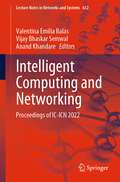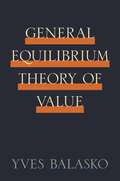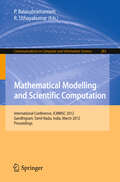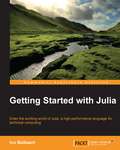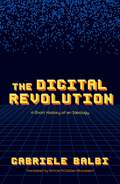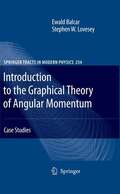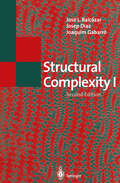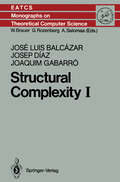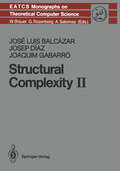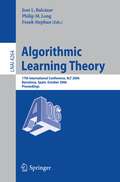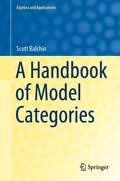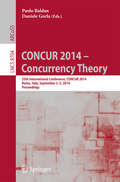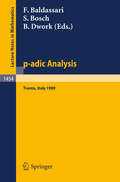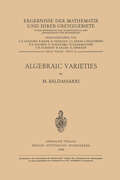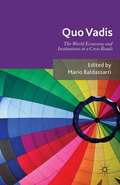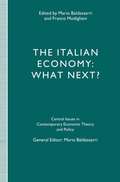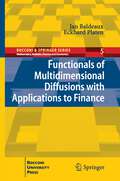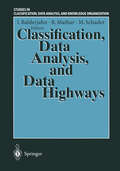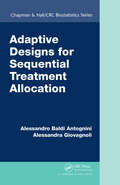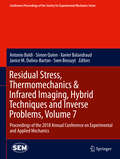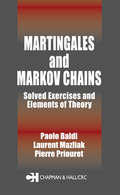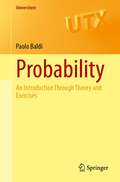- Table View
- List View
Intelligent Computing and Networking: Proceedings of IC-ICN 2022 (Lecture Notes in Networks and Systems #632)
by Valentina Emilia Balas Vijay Bhaskar Semwal Anand KhandareThis book gathers high-quality peer-reviewed research papers presented at the International Conference on Intelligent Computing and Networking (IC-ICN 2022), organized by the Computer Department, Thakur College of Engineering and Technology, in Mumbai, Maharashtra, India, on February 25–26, 2022. The book includes innovative and novel papers in the areas of intelligent computing, artificial intelligence, machine learning, deep learning, fuzzy logic, natural language processing, human–machine interaction, big data mining, data science and mining, applications of intelligent systems in healthcare, finance, agriculture and manufacturing, high-performance computing, computer networking, sensor and wireless networks, Internet of Things (IoT), software-defined networks, cryptography, mobile computing, digital forensics and blockchain technology.
General Equilibrium Theory of Value
by Yves BalaskoThe concept of general equilibrium, one of the central components of economic theory, explains the behavior of supply, demand, and prices by showing that supply and demand exist in balance through pricing mechanisms. The mathematical tools and properties for this theory have developed over time to accommodate and incorporate developments in economic theory, from multiple markets and economic agents to theories of production. Yves Balasko offers an extensive, up-to-date look at the standard theory of general equilibrium, to which he has been a major contributor. This book explains how the equilibrium manifold approach can be usefully applied to the general equilibrium model, from basic consumer theory and exchange economies to models with private ownership of production. Balasko examines properties of the standard general equilibrium model that are beyond traditional existence and optimality. He applies the theory of smooth manifolds and mappings to the multiplicity of equilibrium solutions and related discontinuities of market prices. The economic concepts and differential topology methods presented in this book are accessible, clear, and relevant, and no prior knowledge of economic theory is necessary. General Equilibrium Theory of Value offers a comprehensive foundation for the most current models of economic theory and is ideally suited for graduate economics students, advanced undergraduates in mathematics, and researchers in the field.
General Equilibrium Theory of Value
by Yves BalaskoThe concept of general equilibrium, one of the central components of economic theory, explains the behavior of supply, demand, and prices by showing that supply and demand exist in balance through pricing mechanisms. The mathematical tools and properties for this theory have developed over time to accommodate and incorporate developments in economic theory, from multiple markets and economic agents to theories of production. Yves Balasko offers an extensive, up-to-date look at the standard theory of general equilibrium, to which he has been a major contributor. This book explains how the equilibrium manifold approach can be usefully applied to the general equilibrium model, from basic consumer theory and exchange economies to models with private ownership of production. Balasko examines properties of the standard general equilibrium model that are beyond traditional existence and optimality. He applies the theory of smooth manifolds and mappings to the multiplicity of equilibrium solutions and related discontinuities of market prices. The economic concepts and differential topology methods presented in this book are accessible, clear, and relevant, and no prior knowledge of economic theory is necessary. General Equilibrium Theory of Value offers a comprehensive foundation for the most current models of economic theory and is ideally suited for graduate economics students, advanced undergraduates in mathematics, and researchers in the field.
Mathematical Modelling and Scientific Computation: International Conference, ICMMSC 2012, Gandhigram, Tamil Nadu, India, March 16-18, 2012 (Communications in Computer and Information Science #283)
by P. Balasubramaniam R. UthayakumarThis book constitutes the refereed proceedings of the International Conference on Mathematical Modelling and Scientific Intelligence, ICMMSC 2012, Gandhigram, Tamil Nadu, India, in March 2012. The 62 revised full papers presented were carefully reviewed and selected from 332 submissions. The papers are organized in two topical sections on mathematical modelling and on scientific computation.
Part I: Physical Chemistry. Part II: Solid State Physics (The Collected Works #A / 4)
by N. Balazs W. KohnThe fourth volume of the Collected Works is devoted to Wigners contribution to physical chemistry, statistical mechanics and solid-state physics. One corner stone was his introduction of what is now called the Wigner function, while his paper on adiabatic perturbations foreshadowed later work on Berry phases. Although few in number, Wigners articles on solid-state physics laid the foundations for the modern theory of the electronic structure of metals.
Getting Started with Julia
by Ivo BalbaertThis book is for you if you are a data scientist or working on any technical or scientific computation projects. The book assumes you have a basic working knowledge of high-level dynamic languages such as MATLAB, R, Python, or Ruby.
The Digital Revolution: A Short History of an Ideology
by Gabriele Balbi'A must-read to anyone interested in the digital world.' - Valérie Schafer, Center for Contemporary and Digital History, University of Luxembourg A concise history of the digital revolution and the lore, rhetoric, and debates that surround it. The Digital Revolution aims to tell a story, one of the most powerful ideologies of recent decades: that digitalization constitutes a revolution, a break with the past, a radical change for the human beings who are living through it. The book aims to investigate the origins of this idea, how it evolved, which other past revolutions consciously or unconsciously inspired it, which great stories it has conveyed over time, which of its key elements have changed and which ones have persisted and have been repeated in different historical periods. All these discussions, large or small, have settled and condensed into a series of media, advertising, corporate, political, and technical sources. Readers will be introduced to new, previously unpublished historical sources. The main aim of the book is to deconstruct what looks like a “natural” and incontestable idea and to help rethink digital societies today.
The Digital Revolution: A Short History of an Ideology
by Gabriele Balbi'A must-read to anyone interested in the digital world.' - Valérie Schafer, Center for Contemporary and Digital History, University of Luxembourg A concise history of the digital revolution and the lore, rhetoric, and debates that surround it. The Digital Revolution aims to tell a story, one of the most powerful ideologies of recent decades: that digitalization constitutes a revolution, a break with the past, a radical change for the human beings who are living through it. The book aims to investigate the origins of this idea, how it evolved, which other past revolutions consciously or unconsciously inspired it, which great stories it has conveyed over time, which of its key elements have changed and which ones have persisted and have been repeated in different historical periods. All these discussions, large or small, have settled and condensed into a series of media, advertising, corporate, political, and technical sources. Readers will be introduced to new, previously unpublished historical sources. The main aim of the book is to deconstruct what looks like a “natural” and incontestable idea and to help rethink digital societies today.
Introduction to the Graphical Theory of Angular Momentum: Case Studies (Springer Tracts in Modern Physics #234)
by Ewald Balcar Stephen W. LoveseyApplication of quantum mechanics in physics and chemistry often entails manipulation and evaluation of sums and products of coupling coefficients for the theory of angular momentum. Challenges encountered in such work can be tamed by graphical techniques that provide both the insight and analytical power. The book is the first step-by-step exposition of a graphical method grounded in established work. Copious exercises recover standard results but demonstrate the power to go beyond.
Structural Complexity I (Texts in Theoretical Computer Science. An EATCS Series)
by Jose L. Balcazar Josep Diaz Joaquim GabarroIn the six years since the first edition of this book was published, the field of Structural Complexity has grown quite a bit. However, we are keeping this volume at the same basic level that it had in the first edition, and the only new result incorporated as an appendix is the closure under complementation of nondeterministic space classes, which in the previous edition was posed as an open problem. This result was already included in our Volume II, but we feel that due to the basic nature of the result, it belongs to this volume. There are of course other important results obtained during these last six years. However, as they belong to new areas opened in the field they are outside the scope of this fundamental volume. Other changes in this second edition are the update of some Bibliograph ical Remarks and references, correction of many mistakes and typos, and a renumbering of the definitions and results. Experience has shown us that this new numbering is a lot more friendly, and several readers have confirmed this opinion. For the sake of the reader of Volume II, where all references to Volume I follow the old numbering, we have included here a table indicating the new number corresponding to each of the old ones.
Structural Complexity I (Monographs in Theoretical Computer Science. An EATCS Series #11)
by Jose L. Balcazar Josep Diaz Joaquim GabarroSince the achievement of a fonnal definition of the concept of "algorithm", the Mathematical Theory of Computation has developed into a broad and rich discipline. The notion of "complexity of an algorithm" yields an important area of research, known as Complexity Theory, that can be approached from several points of view. Some of these are briefly discussed in the Introduction and, in particular, our view of the "Structural" approach is outlined there. We feel the subject is mature enough to permit collecting and interrelating many of the results in book fonn. Let us point out that a substantial part of the knowledge in Structural Complexity Theory can be found only in specialized journals, symposia proceedings, and monographs like doctoral dissertations or similar texts, mostly unpublished. We believe that a task to be done soon is a systematization of the interconnections between all the research lines; this is a serious and long task. We hope that the two volumes of this book can serve as a starting point for this systematization process.
Structural Complexity II (Monographs in Theoretical Computer Science. An EATCS Series #22)
by Jose L. Balcazar Josep Diaz Joaquim GabarroThis is the second volume of a two volume collection on Structural Complexity. This volume assumes as a prerequisite knowledge about the topics treated in Volume I, but the present volume itself is nearly self-contained. As in Volume I, each chapter of this book ends with a section entitled "Bibliographical Remarks", in which the relevant references for the chapter are briefly commented upon. These sections might also be of interest to those wanting an overview of the evolution of the field, as well as relevant related results which are not included in the text. Each chapter includes a section of exercises. The reader is encouraged to spend some time on them. Some results presented as exercises are occasionally used later in the text. A reference is provided for the most interesting and for the most useful exercises. Some exercises are marked with a • to indicate that, to the best knowledge of the authors, the solution has a certain degree of difficulty. Many topics from the field of Structural Complexity are not treated in depth, or not treated at all. The authors bear all responsibility for the choice of topics, which has been made based on the interest of the authors on each topic. Many friends and colleagues have made suggestions or corrections. In partic ular we would like to express our gratitude to Richard Beigel, Ron Book, Rafael Casas, Jozef Gruska, Uwe Schoning, Pekka Orponen, and Osamu Watanabe.
Algorithmic Learning Theory: 17th International Conference, ALT 2006, Barcelona, Spain, October 7-10, 2006, Proceedings (Lecture Notes in Computer Science #4264)
by José L. Balcázar Philip M. Long Frank StephanThis book constitutes the refereed proceedings of the 17th International Conference on Algorithmic Learning Theory, ALT 2006, held in Barcelona, Spain in October 2006, colocated with the 9th International Conference on Discovery Science, DS 2006. The 24 revised full papers presented together with the abstracts of five invited papers were carefully reviewed and selected from 53 submissions. The papers are dedicated to the theoretical foundations of machine learning.
A Handbook of Model Categories (Algebra and Applications #27)
by Scott BalchinThis book outlines a vast array of techniques and methods regarding model categories, without focussing on the intricacies of the proofs. Quillen model categories are a fundamental tool for the understanding of homotopy theory. While many introductions to model categories fall back on the same handful of canonical examples, the present book highlights a large, self-contained collection of other examples which appear throughout the literature. In particular, it collects a highly scattered literature into a single volume.The book is aimed at anyone who uses, or is interested in using, model categories to study homotopy theory. It is written in such a way that it can be used as a reference guide for those who are already experts in the field. However, it can also be used as an introduction to the theory for novices.
CONCUR 2014 – Concurrency Theory: 25th International Conference, CONCUR 2014, Rome, Italy, September 2-5, 2014. Proceedings (Lecture Notes in Computer Science #8704)
by Paolo Baldan University of Roma "La Sapienza"This book constitutes the refereed proceedings of the 25th International Conference on Concurrency Theory, CONCUR 2014, held in Rome, Italy in September 2014. The 35 revised full papers presented together with 5 invited talks were carefully reviewed and selected from 124 submissions. The focus of the conference is on the following topics: process calculi, model checking and abstraction, synthesis, quantitative models, automata and multithreading, complexity, process calculi and types, categories, graphs and quantum systems, automata and time, and games.
p-adic Analysis: Proceedings of the International Conference held in Trento, Italy, May 29-June 2, 1989 (Lecture Notes in Mathematics #1454)
by Francesco Baldassari Siegfried Bosch Bernard DworkAlgebraic Varieties (Ergebnisse der Mathematik und ihrer Grenzgebiete. 2. Folge #12)
by M. BaldassarriAlgebraic geometry has always been an ec1ectic science, with its roots in algebra, function-theory and topology. Apart from early resear ches, now about a century old, this beautiful branch of mathematics has for many years been investigated chiefly by the Italian school which, by its pioneer work, based on algebro-geometric methods, has succeeded in building up an imposing body of knowledge. Quite apart from its intrinsic interest, this possesses high heuristic value since it represents an essential step towards the modern achievements. A certain lack of rigour in the c1assical methods, especially with regard to the foundations, is largely justified by the creative impulse revealed in the first stages of our subject; the same phenomenon can be observed, to a greater or less extent, in the historical development of any other science, mathematical or non-mathematical. In any case, within the c1assical domain itself, the foundations were later explored and consolidated, principally by SEVERI, on lines which have frequently inspired further investigations in the abstract field. About twenty-five years ago B. L. VAN DER WAERDEN and, later, O. ZARISKI and A. WEIL, together with their schools, established the methods of modern abstract algebraic geometry which, rejecting the c1assical restriction to the complex groundfield, gave up geometrical intuition and undertook arithmetisation under the growing influence of abstract algebra.
Quo Vadis: World Economy and Institutions at a Crossroads
by Mario BaldassarriThis study addresses the two major challenges facing the global economy: globalization and the European structural crisis. In addition, it takes a closer look at the impact of this on the Italian economy. The findings reflect on the issue of long term growth and suggest ways in which to create sustainable financial conditions for the future.
The Italian Economy: What Next? (Central Issues in Contemporary Economic Theory and Policy)
by Mario Baldassarri Franco ModiglianiSince the early 1970s the Italian economy has been moving towards an irreversible real and financial crisis. Paradoxically, the conditions engendered by the currency crisis and recession may also provide the basis for a new economic policy strategy, which could lead to built a mere 'economic miracle!'
Functionals of Multidimensional Diffusions with Applications to Finance (Bocconi & Springer Series #5)
by Jan Baldeaux Eckhard PlatenThis research monograph provides an introduction to tractable multidimensional diffusion models, where transition densities, Laplace transforms, Fourier transforms, fundamental solutions or functionals can be obtained in explicit form. The book also provides an introduction to the use of Lie symmetry group methods for diffusions, which allows to compute a wide range of functionals. Besides the well-known methodology on affine diffusions it presents a novel approach to affine processes with applications in finance. Numerical methods, including Monte Carlo and quadrature methods, are discussed together with supporting material on stochastic processes. Applications in finance, for instance, on credit risk and credit valuation adjustment are included in the book. The functionals of multidimensional diffusions analyzed in this book are significant for many areas of application beyond finance. The book is aimed at a wide readership, and develops an intuitive and rigorous understanding of the mathematics underlying the derivation of explicit formulas for functionals of multidimensional diffusions.
Classification, Data Analysis, and Data Highways: Proceedings of the 21st Annual Conference of the Gesellschaft für Klassifikation e.V., University of Potsdam, March 12–14, 1997 (Studies in Classification, Data Analysis, and Knowledge Organization)
by Ingo Balderjahn Rudolf Mathar Martin SchaderAdaptive Designs for Sequential Treatment Allocation
by Alessandro Baldi Antognini Alessandra GiovagnoliAdaptive Designs for Sequential Treatment Allocation presents a rigorous theoretical treatment of the results and mathematical foundation of adaptive design theory. The book focuses on designing sequential randomized experiments to compare two or more treatments incorporating information accrued along the way. The authors first introduce the termin
Residual Stress, Thermomechanics & Infrared Imaging, Hybrid Techniques and Inverse Problems, Volume 7: Proceedings of the 2018 Annual Conference on Experimental and Applied Mechanics (Conference Proceedings of the Society for Experimental Mechanics Series)
by Antonio Baldi Simon Quinn Xavier Balandraud Janice M. Dulieu-Barton Sven BossuytResidual Stress, Thermomechanics & Infrared Imaging, Hybrid Techniques and Inverse Problems, Volume 7 of the Proceedings of the 2018 SEM Annual Conference & Exposition on Experimental and Applied Mechanics, the seventh volume of eight from the Conference, brings together contributions to this important area of research and engineering. The collection presents early findings and case studies on a wide range of areas, including: Inverse Problems/Hybrid TechniquesMaterial Characterizations Using ThermographyThermoelastic Stress AnalysisFatigue & Damage Evaluation Using Infrared ThermographyIntegration of Infrared Thermography & DICThermographic Non-Destructive Evaluation (NDE)
Martingales and Markov Chains: Solved Exercises and Elements of Theory
by Paolo BaldiA thorough grounding in Markov chains and martingales is essential in dealing with many problems in applied probability, and is a gateway to the more complex situations encountered in the study of stochastic processes. Exercises are a fundamental and valuable training tool that deepen students' understanding of theoretical principles and prepare th
Probability: An Introduction Through Theory and Exercises (Universitext)
by Paolo BaldiThis textbook offers a complete one-semester course in probability, covering the essential topics necessary for further study in the areas of probability and statistics. The book begins with a review of the fundamentals of measure theory and integration. Probability measures, random variables, and their laws are introduced next, along with the main analytic tools for their investigation, accompanied by some applications to statistics. Questions of convergence lead to classical results such as the law of large numbers and the central limit theorem with their applications also to statistical analysis and more. Conditioning is the next main topic, followed by a thorough introduction to discrete time martingales. Some attention is given to computer simulation. Through the text, over 150 exercises with full solutions not only reinforce the concepts presented, but also provide students with opportunities to develop their problem-solving skills, and make this textbook suitable for guided self-study. Based on years of teaching experience, the author's expertise will be evident in the clear presentation of material and the carefully chosen exercises. Assuming familiarity with measure and integration theory as well as elementary notions of probability, the book is specifically designed for teaching in parallel with a first course in measure theory. An invaluable resource for both instructors and students alike, it offers ideal preparation for further courses in statistics or probability, such as stochastic calculus, as covered in the author's book on the topic.
